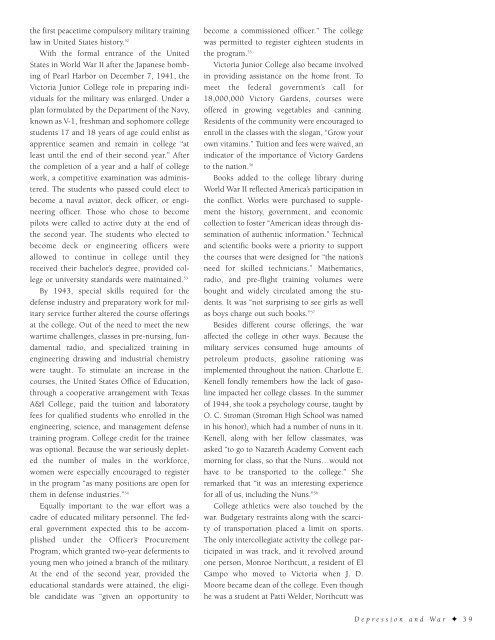The Victoria College, 1925-2000: A Tradition of Excellence
A history of the Victoria College of Victoria, Texas, published to commemorate the institution's 75th anniversary.
A history of the Victoria College of Victoria, Texas, published to commemorate the institution's 75th anniversary.
- No tags were found...
Create successful ePaper yourself
Turn your PDF publications into a flip-book with our unique Google optimized e-Paper software.
the first peacetime compulsory military training<br />
law in United States history. 52<br />
With the formal entrance <strong>of</strong> the United<br />
States in World War II after the Japanese bombing<br />
<strong>of</strong> Pearl Harbor on December 7, 1941, the<br />
<strong>Victoria</strong> Junior <strong>College</strong> role in preparing individuals<br />
for the military was enlarged. Under a<br />
plan formulated by the Department <strong>of</strong> the Navy,<br />
known as V-1, freshman and sophomore college<br />
students 17 and 18 years <strong>of</strong> age could enlist as<br />
apprentice seamen and remain in college “at<br />
least until the end <strong>of</strong> their second year.” After<br />
the completion <strong>of</strong> a year and a half <strong>of</strong> college<br />
work, a competitive examination was administered.<br />
<strong>The</strong> students who passed could elect to<br />
become a naval aviator, deck <strong>of</strong>ficer, or engineering<br />
<strong>of</strong>ficer. Those who chose to become<br />
pilots were called to active duty at the end <strong>of</strong><br />
the second year. <strong>The</strong> students who elected to<br />
become deck or engineering <strong>of</strong>ficers were<br />
allowed to continue in college until they<br />
received their bachelor’s degree, provided college<br />
or university standards were maintained. 53<br />
By 1943, special skills required for the<br />
defense industry and preparatory work for military<br />
service further altered the course <strong>of</strong>ferings<br />
at the college. Out <strong>of</strong> the need to meet the new<br />
wartime challenges, classes in pre-nursing, fundamental<br />
radio, and specialized training in<br />
engineering drawing and industrial chemistry<br />
were taught. To stimulate an increase in the<br />
courses, the United States Office <strong>of</strong> Education,<br />
through a cooperative arrangement with Texas<br />
A&I <strong>College</strong>, paid the tuition and laboratory<br />
fees for qualified students who enrolled in the<br />
engineering, science, and management defense<br />
training program. <strong>College</strong> credit for the trainee<br />
was optional. Because the war seriously depleted<br />
the number <strong>of</strong> males in the workforce,<br />
women were especially encouraged to register<br />
in the program “as many positions are open for<br />
them in defense industries.” 54<br />
Equally important to the war effort was a<br />
cadre <strong>of</strong> educated military personnel. <strong>The</strong> federal<br />
government expected this to be accomplished<br />
under the Officer’s Procurement<br />
Program, which granted two-year deferments to<br />
young men who joined a branch <strong>of</strong> the military.<br />
At the end <strong>of</strong> the second year, provided the<br />
educational standards were attained, the eligible<br />
candidate was “given an opportunity to<br />
become a commissioned <strong>of</strong>ficer.” <strong>The</strong> college<br />
was permitted to register eighteen students in<br />
the program. 55<br />
<strong>Victoria</strong> Junior <strong>College</strong> also became involved<br />
in providing assistance on the home front. To<br />
meet the federal government’s call for<br />
18,000,000 Victory Gardens, courses were<br />
<strong>of</strong>fered in growing vegetables and canning.<br />
Residents <strong>of</strong> the community were encouraged to<br />
enroll in the classes with the slogan, “Grow your<br />
own vitamins.” Tuition and fees were waived, an<br />
indicator <strong>of</strong> the importance <strong>of</strong> Victory Gardens<br />
to the nation. 56<br />
Books added to the college library during<br />
World War II reflected America’s participation in<br />
the conflict. Works were purchased to supplement<br />
the history, government, and economic<br />
collection to foster “American ideas through dissemination<br />
<strong>of</strong> authentic information.” Technical<br />
and scientific books were a priority to support<br />
the courses that were designed for “the nation’s<br />
need for skilled technicians.” Mathematics,<br />
radio, and pre-flight training volumes were<br />
bought and widely circulated among the students.<br />
It was “not surprising to see girls as well<br />
as boys charge out such books.” 57<br />
Besides different course <strong>of</strong>ferings, the war<br />
affected the college in other ways. Because the<br />
military services consumed huge amounts <strong>of</strong><br />
petroleum products, gasoline rationing was<br />
implemented throughout the nation. Charlotte E.<br />
Kenell fondly remembers how the lack <strong>of</strong> gasoline<br />
impacted her college classes. In the summer<br />
<strong>of</strong> 1944, she took a psychology course, taught by<br />
O. C. Stroman (Stroman High School was named<br />
in his honor), which had a number <strong>of</strong> nuns in it.<br />
Kenell, along with her fellow classmates, was<br />
asked “to go to Nazareth Academy Convent each<br />
morning for class, so that the Nuns…would not<br />
have to be transported to the college.” She<br />
remarked that “it was an interesting experience<br />
for all <strong>of</strong> us, including the Nuns.” 58<br />
<strong>College</strong> athletics were also touched by the<br />
war. Budgetary restraints along with the scarcity<br />
<strong>of</strong> transportation placed a limit on sports.<br />
<strong>The</strong> only intercollegiate activity the college participated<br />
in was track, and it revolved around<br />
one person, Monroe Northcutt, a resident <strong>of</strong> El<br />
Campo who moved to <strong>Victoria</strong> when J. D.<br />
Moore became dean <strong>of</strong> the college. Even though<br />
he was a student at Patti Welder, Northcutt was<br />
Depression and War ✦ 39















